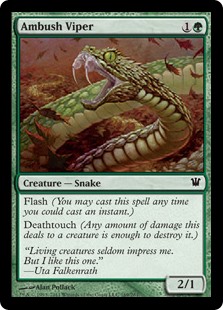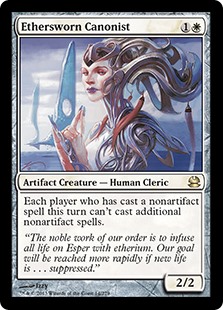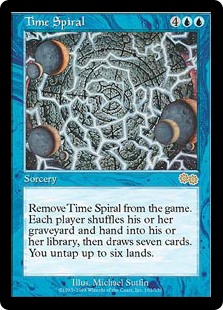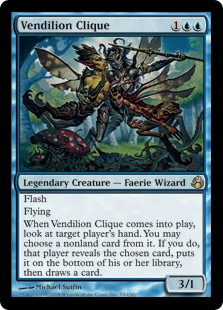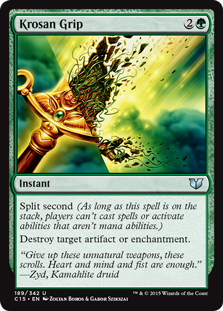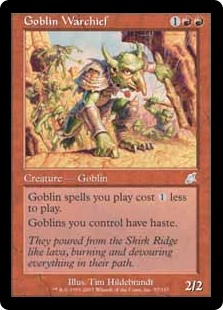Hi everyone! Today I want to talk about [casthaven]Aether Vial[/casthaven]. It is a powerful one mana artifact, and a staple in both Modern and Legacy. In this article we will delve into when and why you should be playing with [casthaven]Aether Vial[/casthaven], as well as how to make the best use of it in game.
[casthaven]Aether Vial[/casthaven] at its core is a mana source. While it doesn’t literally produce mana, it lets you put your creatures into play without having to pay for them. A single vial can effectively net you two to five mana every turn, making it a very powerful card. It is not without its restrictions however, as [casthaven]Aether Vial[/casthaven] only work with creatures. Therefore, in order for it to be good you need to:
Play a lot of creatures.
[casthaven]Aether Vial[/casthaven] is among the most powerful cards ever printed, assuming you get to use it to its full effect. Ideally you want to be activating it every turn, and in order to consistently do so you need a lot of creatures.
Have most of your creatures cost 2-4 mana.
Using [casthaven]Aether Vial[/casthaven] to help play your one drops isn’t nearly as powerful, and playing a deck with thirty six drops just isn’t realistic. A high concentration of creatures with converted mana cost two to four is preferable. (Gregory Hatch’s Mono Blue Martyr deck is the exception.)
Have something else to do with your mana.
Playing an [casthaven]Aether Vial[/casthaven] on turn one frees up a lot of your mana. Don’t let that mana go to waste! Whether it’s playing multiple spells per turn or using lands like [casthaven]Rishadan Port[/casthaven] to disrupt your opponent, you want to make sure to get the most out of your lands that are no longer locked into help paying for your creatures.
Aside from simply being a way to put your creatures into play, [casthaven]Aether Vial[/casthaven] also fulfils two very important functions—letting you do so at instant speed and without giving your opponent a proper chance to respond. This not only makes it very effective against countermagic, but also means your opponent won’t know what you’re going to put into play until it’s already hit the battlefield! When you cast a [casthaven]Phyrexian Revoker[/casthaven] your opponent can flip their [casthaven]Sensei’s Divining Top[/casthaven] in response. When you play an [casthaven]Aven Mindcensor[/casthaven] they can crack those fetchlands while it’s on the stack. With [casthaven]Aether Vial[/casthaven], they will be forced to correctly predict what you’re up to—or risk being severely punished.
The pseudo-flash ability of [casthaven]Aether Vial[/casthaven] is not to be underestimated either. It protects you from sorcery speed removal. It lets you wait and see what your opponent does on their turn before deciding what to search for with your [casthaven]Goblin Matron[/casthaven] or [casthaven]Recruiter of the Guard[/casthaven]. It turns every card in your hand into a potential [casthaven]Ambush Viper[/casthaven] and allows for all sorts of cool trick with various hatebears!
When to tick it up?
It’s the beginning of your upkeep. You have an [casthaven]Aether Vial[/casthaven] with two counters on it. Should you put another counter on it? This is perhaps the most common decision you will have to make with Vial, and getting it wrong could prove disastrous for your chances of winning the game. How do we figure out the right play?
First of all, most decks with [casthaven]Aether Vial[/casthaven] have a sweet spot; a number which is the default amount of counters you want on your [casthaven]Aether Vial[/casthaven]. For Death & Taxes that number is two to three. For Goblins it’s between three and four. Knowing your deck well and being familiar with it really helps here. It should be noted that the numbers I’ve listed are a bit higher than what one might expect. The average Goblin deck plays eight to twelve three drops and only four to seven four drops. Why shouldn’t the default number just be three? Two words: mana efficiency. It’s simply a more efficient use of your mana to rely on [casthaven]Aether Vial[/casthaven] to play your more expensive creatures, leaving your lands to pay for your cheaper spells.
The second step is to consider the contents of your hand. Are you holding a bunch of two drops? Multiple copies of [casthaven]Goblin Ringleader[/casthaven]? It shouldn’t come as a surprise to anyone that having more creatures with a converted mana cost of X usually equals X being a good number of counters to have on your Vial. What is not as obvious are the other, more subtle ways in which the cards you have can and should affect the decision of whether or not to tick up your Vial. For example, how many lands you have.
Consider the following scenario. You’re playing Goblins and both players are in topdeck mode. You have two lands, no cards in hand, and an [casthaven]Aether Vial[/casthaven] with three counters on it. Do you tick it up? Personally, I wouldn’t most of the time, and it all comes down to one basic truth about Vial.
You can tick it up, but you can’t tick it down.
In general, not being able to play your spells at all is a lot worse than having to play them a turn late. If you leave your vial on three and then draw a Ringleader all you have to do is wait a turn before putting it into play. But if you tick it up to four, then there’s no going back. So if you draw a three drop you better hope you find a third land to go with it, because otherwise it’s going to get stranded in your hand.
This works a bit differently when there is discard involved. Against [casthaven]Liliana of the Veil[/casthaven] for example, you can’t really leave a card in your hand for a turn, because it’s just going to get discarded. You’ll have reevaluate accordingly.
While mana efficiency is important, don’t underestimate the instant speed ability of [casthaven]Aether Vial[/casthaven]. Pay attention to when it might be correct to deviate from the default position. Sometimes you have to leave your Vial on an otherwise inconvenient number to play around the very thing that could cause you to lose. Don’t let them catch you off guard with an end-of-turn [casthaven]Crop Rotation[/casthaven] into [casthaven]Dark Depths[/casthaven] plus [casthaven]Thespian’s Stage[/casthaven] when you have a [casthaven]Stingscourger[/casthaven] or [casthaven]Palace Jailer[/casthaven] in hand.
Tips & Tricks!
Now we get to the fun part! It’s time to learn about all the cool tricks that you can do with an [casthaven]Aether Vial[/casthaven] in play.
One of the easiest ways to get someone with [casthaven]Aether Vial[/casthaven] is the surprise blocker. [casthaven]Mogg War Marshal[/casthaven] and [casthaven]Thalia, Guardian of Thraben[/casthaven] both make for excellent blockers and can easily catch unsuspecting opponents off guard, turning their “free damage” into a chump attack.
Sometimes when I’m playing Goblins I even go as far as to hold my [casthaven]Mogg War Marshal[/casthaven] until I can vial it into play. After all, I didn’t do anything with my mana on turn two, so that probably means I don’t have it, right? Sometimes you get to eat one of their creatures in combat. Other times you just saved yourself some life. Either way, it’s a sweet deal for you!
Have you ever played an [casthaven]Ethersworn Canonist[/casthaven] only to have them remove it on your end step and proceed to combo off on their turn? Not only does [casthaven]Aether Vial[/casthaven] protect your creatures from bounce spells, but you can play around removal by forcing the opponent to commit more cards to their combo. By waiting until after they’ve cast a bunch of rituals to put Canonist into play you’ve effectively made those rituals go to waste, and now it’s going to be difficult for them to win even with a removal spell.
Speaking of hate bears, a single Vial on two can make life difficult for your [casthaven]High Tide[/casthaven] opponent. Every [casthaven]Time Spiral[/casthaven] they cast gives you seven more chances at drawing into a canonist or Thalia, and thanks to [casthaven]Aether Vial[/casthaven] you can put it into play on their turn!
If you suspect your opponent might be playing [casthaven]Vendilion Clique[/casthaven], remember to be careful when activating [casthaven]Aether Vial[/casthaven]. It’s easy to get overly excited when you topdeck [casthaven]Goblin Ringleader[/casthaven] and tap that Vial right away, but that lets them respond to your Vial activation with [casthaven]Vendilion Clique[/casthaven] and take away your Ringleader (or whatever card you wanted to vial into play). Consider just casting your creature instead, or if you should wait until their upkeep to vial it into play. At least this way you force them to spend the mana on their turn.
You can also use vial activations to bait a Clique, or sometimes even a [casthaven]Stifle[/casthaven] from your opponent. Having your opponent cast [casthaven]Stifle[/casthaven] when you activate an Aether Vial with nothing to put into play is a great feeling. It’s also a very low risk bluff!
This doesn’t come up as often, but Split Second is a very dangerous mechanic that is easy to forget about. Try not to get blown out by [casthaven]Krosan Grip[/casthaven] or [casthaven]Wipe Away[/casthaven] when playing with [casthaven]Aether Vial[/casthaven]. You don’t always have to wait until the last possible moment to activate it. In a similar vein, if your opponent plays a [casthaven]Pithing Needle[/casthaven] or [casthaven]Phyrexian Revoker[/casthaven], remember that you can’t respond to them naming a card. If you want to use your [casthaven]Aether Vial[/casthaven] that turn, you’re going to have to do so while their card is on the stack—assuming that they’re going to name [casthaven]Aether Vial[/casthaven] with it.
[casthaven]Aether Vial[/casthaven] can help you play around a removal spell on your creatures with activated abilities. If you’re looking to get some [casthaven]Goblin Sharpshooter[/casthaven] action going, just play it from your hand and pass. If your opponent tries to remove it you can respond by putting [casthaven]Goblin Warchief[/casthaven] into play and start pinging their creatures with Sharpshooter before it’s removed. If they elect not to play the removal spell you simply untap and start activating Sharpshooter on your turn.
My hope is that this article will have given you a better understanding of one of Legacy’s most iconic cards. Do you have a cool memory of [casthaven]Aether Vial[/casthaven] you would like to share? Send me your favorite Vial stories on Twitter!


